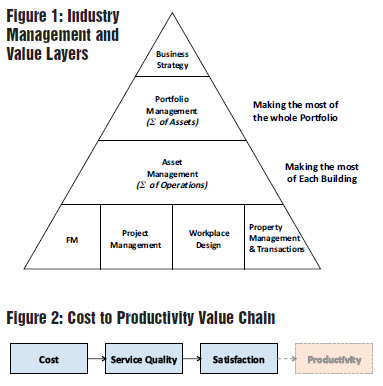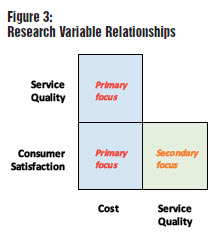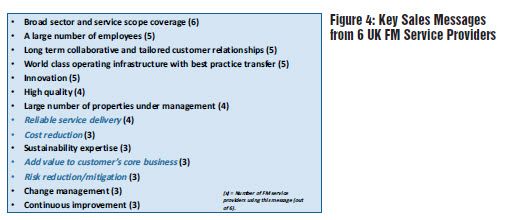by Dr Barry Varcoe BSc (Hons) PhD FRICS — WITHOUT DOUBT THE DISCIPLINE of FM has come a long way over the last 25 or so years that I have been involved with it. The operation of commercial buildings is now an accepted component of the wider property function, as indeed it is of the overall business model of the enterprise. But now that FM is of an age to be considered mature, is it reaching the evolutionary limit of capability and benefit that the current approach, structure and mindset can achieve?
The business of providing organisations with the productive places of work they need to thrive is a very fractured one. I experienced this first hand as the group-wide property director for an international financial services organisation.
Consider how FM needs to fit into the overall ‘property’ provision alongside construction project management, workplace design and real estate. It is only when the key knowledge from each of these functions is aggregated that a true and complete picture of each asset can be obtained, allowing it to be properly managed.

And it is only when all of the information from all of the assets can be brought together that a true picture of the entire portfolio can be made available – which is vital as it is at this level that most value can be achieved (see figure 1).
Bringing all of this together across all of the silo’d industry components and professions is no mean feat. FM in reality is an amalgam of yet another set of industries, professions and trades – maintenance, cleaning, security, food services etc. The term ‘integrated’ is often applied, but is this correct? To ‘integrate’ means to ‘unite or combine… to form a whole’. But what usually happens is the application of a management veneer that is more of a ‘co-ordination’ effort – ‘bringing together the different elements of a complex activity into an efficient relationship’.
|
|
This distinction goes beyond mere semantics as there is a big difference in the outcomes each delivers. Co-ordination seeks to remove problems so that the parts can achieve a value equal to the sum of their individual parts. Integration (which in my experience hardly ever happens, if at all) goes way beyond the removal of negatives (it starts there, not finishes) and seeks to add value that is more than the sum of the parts.
What evidence is there that these fractures count for anything? Research I have recently completed for a doctorate at Glasgow Caledonian University provides some clarity. I decided to analyse the regularly quoted and supposed relationship between cost, quality and satisfaction in offices.
The hypothesis, that arguably underpins much of the industry, is that in general terms the more you spend on facilities the higher quality you get for your money and the more satisfied the occupants will be.
The FM literature often then goes one (big) step further by asserting that higher satisfaction leads to higher productivity (see figure 2).
|
|
A field study collected data from 154 office facilities in the UK and 1,887 respondents – a large sample. A robust customer satisfaction measurement survey tool was developed as part of this (to print off an introductory version visit www.reresonance.com).
The data collected was analysed at multiple levels using proven statistical techniques to seek any correlation relationships between the three variables (see figure 3). This was carried out at both an individual function level (eg. Cleaning cost to cleaning quality to cleaning satisfaction), and at an overall level (eg. FM cost to FM quality to FM satisfaction). The results were conclusive.
There were no meaningful correlations to be found. (Although statistically there were some significant relationships these were all very weak and of no practical consequence).
If true across the entire industry, this is a finding of potentially profound importance. It suggests that FM does not operate as a ‘system’ and it is not a truly connected series of activities consistent with my earlier observations about its fractured nature. This could be having serious consequences. By definition it means, for example, that FM is not able to systematically learn and develop. Advances in practice tend to be very local and kept private to the cast of characters and organisations directly involved. Wider dissemination of new knowledge is ‘hit and miss’.
We are an industry that has evolved through lots and lots of little steps, many being repeated over and over as we each discover for ourselves knowledge that could and should be common. This is evidenced also by the nature of the learning that does get shared, which for the most part is the articulation of practices that for whatever reason are perceived by conventional wisdom to be worthy of being labelled ‘best’. Hard data-based evidence to back up any such claims of performance achievement is in short supply.
This is matched by the comparative paucity of academic research. Given the overall size of the industry, the amount of structured research being undertaken in Universities and other institutions is, in my view, lamentable. To be clear I am not being critical of the work they are doing, rather the lack of support and engagement of the FM industry they receive.
All this has lead FM into the position it finds itself in today where it is increasingly becoming a commodity – many providers selling different flavours of the same thing differentiated by price.
I sought further evidence for this by studying the websites of six leading national and international FM service providers that operate in the UK. In particular I was interested in what they said about themselves as they sought to communicate what they offered their customers.
The results of what I found are summarised in figure 4. At least two conclusions are clear. Firstly all of the suppliers are saying more or less the same thing. Secondly it is notable how much of the messaging refers to characteristics about themselves (e.g. we have a lot of staff in lots of locations serving lots of happy customers) rather than focusing on the tangible benefits they bring their customers. The few claims that are output/benefit driven and for their customers benefit are shown in italics. This demonstrates an alarming level of introspection.
The world and business has moved on and now FM needs to as well. It is no longer good enough to say that you deliver high quality or have reliable service delivery – that is expected if not assumed. What do you bring that will make a real difference? We need to establish a knowledge base about what is really going on with real data from the coal-face of the operational business about the resources being applied, the outcomes they achieve, and their business consequences.
|
|
This would then enable us to move forward in a second way, which is to focus on what we deliver as outcomes rather than obsess for the most part about how we look doing it. Business is interested in results that matter – the more we can robustly evidence this and communicate it the more chance we have got of being seen to be a valuable component of the enterprise value-chain.Without this we will deservedly be left behind.
And thirdly, encouraged by our success at being relevant we need to be far more inquisitive about the world around us and all the learning that already exists in other professions and disciplines that we can usefully use ourselves.
I found a good example of this while seeking to understand reasons as to why there were no correlations of any meaning between customer satisfaction and cost and quality respectively I looked at the marketing research literature and discovered a huge body of work with some very interesting insights. Essentially it quickly taught me that we have all for the most part taken a very simplistic view of customer satisfaction in FM – the model we need to understand and deploy is more complex. Figure 5 illustrates what I discovered. In particular the significance of prior satisfaction as a big influence on current satisfaction should not be underestimated, nor the power of expectations.
For me it was also interesting to observe how many variables in reality exist between those I sought to measure and link (cost, quality and satisfaction). We clearly have a long way to go before fully understanding how these relationships work so that we can then creatively use and take advantage of them. Also of significance is the distinction between ‘customers’ and ‘consumers’ – customers usually have the ability to control the purchase decision, whereas consumers may not. Most of our ‘customers’ are in fact ‘consumers’ with little power to individually influence what they receive from us – a position that probably drives a degree of scepticism if not cynicism about the service they receive and their perceived satisfaction of it as a starting point!
I think it is reasonable to say that we are at a crisis point in the evolution of the FM industry. There is no ‘do nothing’ option without a consequence. If we stay as we are we risk a downward ‘death spiral’ into more commoditisation, even lower margins and insignificant value. If we recognise that, although we have come a long way, there is still a lot further to go and that the time has been reached when we need to individually and collectively change our approach, then the future promises to be very bright indeed
Dr Barry Varcoe BSc (Hons) PhD FRICS. is a consultant, researcher, writer on the corporate real estate and FM and past chair CoreNet Global. In his new business Real Estate Resonance, he will work with organisations and people who, like him, are passionate about advancing the capability of corporate real estate and FM for the benefit of its various ‘customer’ stakeholders.


